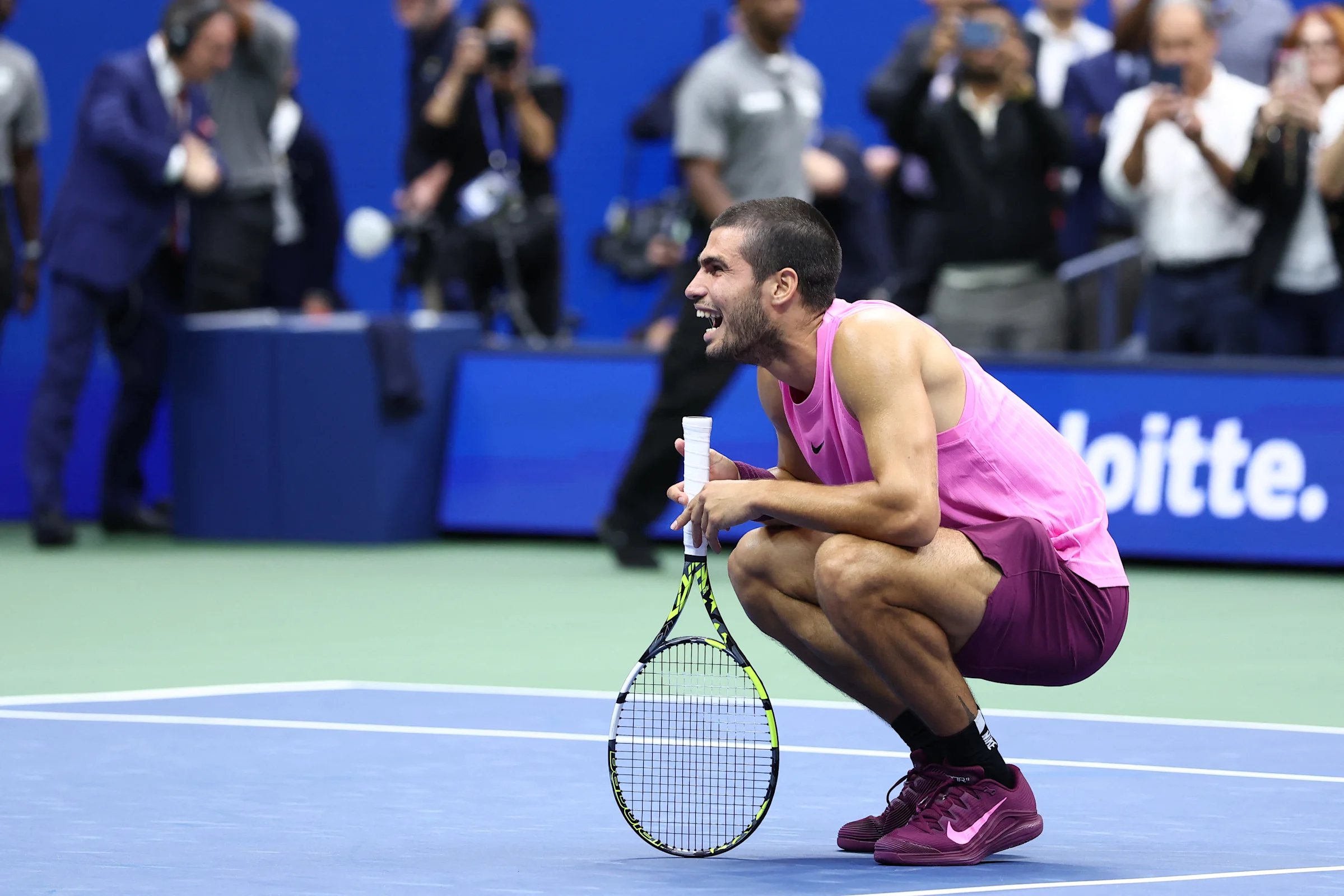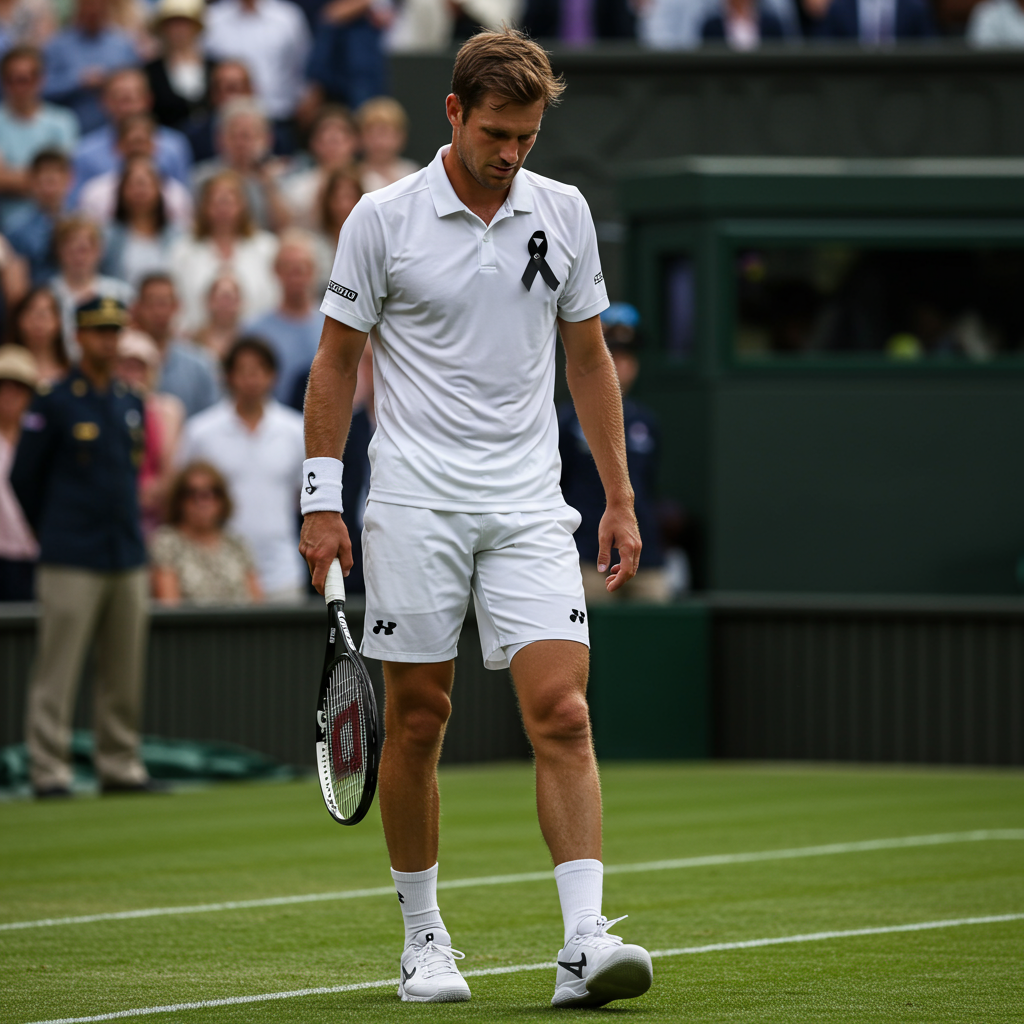The 2025 US Open Tennis Final etched its place in history, not only for a thrilling championship match but also for an unprecedented convergence of high-stakes sport and political spectacle. Carlos Alcaraz delivered a dominant performance, securing his second US Open men’s singles title against formidable rival Jannik Sinner. This victory propelled Alcaraz to the world No. 1 ranking, solidifying his status as a leading force in men’s tennis. However, the final day was equally defined by significant security disruptions and controversy surrounding a presidential visit, profoundly impacting the fan experience and raising questions about the event’s integrity.
Alcaraz Dominates Sinner in Landmark US Open Final
On September 7, 2025, Arthur Ashe Stadium was the stage for a highly anticipated clash between two of tennis’s brightest stars. Carlos Alcaraz overcame Jannik Sinner in four sets (6-2, 3-6, 6-1, 6-4) to claim his second Grand Slam title of the year and his second US Open championship. The match showcased Alcaraz’s strategic brilliance and aggressive play, ultimately preventing Sinner from winning consecutive US Open titles and securing his second Grand Slam victory over Alcaraz for the year. This intense rivalry has now defined 2025 men’s tennis, with Alcaraz holding a 2-1 Grand Slam advantage.
The Battle for Supremacy: Alcaraz vs. Sinner
From the outset, Alcaraz approached the final with a clear intent to dominate, adopting a more aggressive strategy than in his semifinal match against Novak Djokovic. He aimed to avoid another protracted five-set battle, reminiscent of their epic French Open encounter. Alcaraz unleashed a diverse array of shots, masterfully combining powerful serves with effective forehand returns that constantly forced Sinner to stretch across the court. Sinner struggled early, failing to find his rhythm and landing clean serves, which allowed Alcaraz to secure multiple crucial breaks.
The first set saw Alcaraz surge ahead, winning 6-2. This opening presented an interesting historical twist: in their 2025 Grand Slam meetings, the player winning the first set had previously lost the match. Sinner then mounted a strong comeback in the second set. He seemed to settle after Alcaraz’s initial onslaught, finding his touch on his forehand and executing deep corner shots, precise drop shots, and powerful drives past Alcaraz at the net. Sinner capitalized on this momentum, winning the second set 6-3.
Key Match Moments and Tactical Masterclass
Any hopes for a prolonged classic were quickly dashed as Alcaraz regained control in the third set. He rapidly established a commanding 3-0 lead, dictating play with powerful forehands that moved Sinner from side to side before finishing points with delicate drop shots at the net. Sinner continued to face challenges with his serve, being broken four times by the end of the fourth set. This led some observers to speculate about a possible injury or illness hindering his performance, as Alcaraz convincingly took the third set 6-1.
Although Sinner managed a much-needed hold to begin the fourth set, appearing capable of pushing for a decisive fifth, he couldn’t secure the pivotal break needed for an advantage. Alcaraz maintained his composure and ultimately sealed the championship with a blistering ace, an unreturnable shot that concluded the high-stakes encounter. This victory improved Alcaraz’s head-to-head record against Sinner to 10-5, having won seven of their last eight matches.
A Controversial Spectacle: President Trump’s Visit
Beyond the on-court drama, the 2025 US Open Men’s Final was significantly overshadowed by the attendance of President Donald Trump. His visit, the first by a sitting US President to Flushing Meadows since Bill Clinton in 2000, sparked widespread controversy, logistical chaos, and ethical debates. Announced a week in advance, Trump’s presence necessitated heightened security protocols that led to considerable delays and frustration for thousands of ticket-holding fans.
Unprecedented Security and Match Delays
The match’s original 2 p.m. start time was pushed back to 2:30 p.m. due to the enhanced security measures. Spectators and media were advised to arrive early, but many were unprepared for the extent of the disruption. Every bag underwent thorough inspection, with around 30 TSA-level security scanners at stadium entry points—an unusual setup for the US Open. President Trump arrived at Arthur Ashe Stadium around 1:45 p.m. ET, an estimated 45 minutes before the original scheduled start, when the venue was reportedly only about 10% full.
Trump, accompanied by a high-profile entourage including White House chief of staff Susie Wiles, Attorney General Pam Bondi, and Treasury Secretary Scott Bessent, received a mixed reception. Cheers were reportedly drowned out by loud boos when he was shown on the tournament feeds before the match and during the national anthem. A second appearance on the jumbotron at the end of the first set was met with an even louder chorus of disapproval from the crowd. He was observed in a corporate suite as a guest of Rolex, a detail juxtaposed against his administration’s recent tariffs on Swiss-made products.
The USTA’s Controversial Censorship Directive
Adding to the day’s controversy, the United States Tennis Association (USTA) issued a highly criticized directive to its broadcast partners, including ABC and the ESPN app. This memo explicitly requested broadcasters to “refrain from showcasing any disruptions to the President’s attendance in any capacity” and to avoid showing “any individuals who might boo or cause a disturbance.” This move was widely condemned as “cowardly, hypocritical and un-American” by critics like Bryan Armen Graham, who argued it sacrificed the USTA’s credibility by shielding a politician from public disapproval.
Critics highlighted the USTA’s history of televising various “disruptions,” including climate protesters and general “drunken buffoonery,” suggesting that drawing the line at booing a politician was not “policy consistency” but “capitulation.” This directive was seen as an attempt to manage public perception and insulate Trump from potential negative reactions from a global audience, especially given his loud booing during a previous visit in 2015.
Frustration on the Grounds: A Marred Fan Experience
The impact of the presidential visit on the average fan was profound and negative. Thousands of attendees faced extensive delays and significant frustration. Leah Gomberg, a 57-year-old fan, recounted waiting approximately four hours in total, including unexpected traffic and an hour and twenty minutes just to reach the security scanners. She observed large sections of the stadium remaining empty as the match began, despite fans having “paid a lot of money to get into our seats.” Announcers on air noted that many fans were “caught off guard” by the heightened security, having not been adequately prepared.
Princess Doe from Toronto, who paid around $635 for her ticket, described her experience as a “once-in-a-lifetime opportunity” marred by over an hour’s wait in line despite arriving early. Many frustrated but polite fans were seen watching the match on big screens while still waiting to enter. This widespread unpreparedness and dissatisfaction underscored how high-profile visits, even to public sporting events, can severely impact attendee experience due to stringent, and often poorly communicated, security protocols.
The Broader Implications: Tennis’s New Era and Event Integrity
Alcaraz’s triumph solidified his position at the apex of men’s tennis. As a direct consequence of this win, he is set to surpass Sinner as the world No. 1 in the ATP rankings. The 2025 season marked a significant trend: all four Grand Slam events were won by either Carlos Alcaraz or Jannik Sinner. Alcaraz secured the French Open and US Open, while Sinner claimed Wimbledon, suggesting a powerful duopoly will likely dominate the sport for the foreseeable future. Their consistently high level of play has set them apart from other competitors.
A New Era: Alcaraz Ascends to World No. 1
The ascension of Carlos Alcaraz to the world No. 1 ranking is a testament to his incredible talent, relentless work ethic, and ability to perform under pressure. His victory at the US Open is not merely another title; it signifies a changing guard in men’s tennis, ushering in an era where Alcaraz and Sinner are the definitive players to watch. Their rivalry is already drawing comparisons to historic matchups, promising thrilling competition for years to come. This consistent Grand Slam success highlights a remarkable depth in their respective games.
US Open’s Identity: Sport, Spectacle, and Politics
The 2025 US Open Final proved to be a multifaceted event, blending elite sporting competition with significant political and social commentary. In contrast to the high-profile celebrity attendance at the women’s final—which saw stars like Naomi Watts, Stephen Colbert, and Wayne Gretzky enjoying luxury boxes—the men’s final was defined by friction and public disapproval. The USTA’s decision to censor crowd reactions against President Trump was widely perceived as a betrayal of the US Open’s “brash and democratic, rowdy and unfiltered” spirit. This move ironically occurred as the Open celebrated “75 years of breaking barriers,” diminishing its proud history of progressivism and authenticity. The event underscored the growing intersection of major sporting events with political figures, and the complex challenges this poses for organizers in maintaining event integrity and fan satisfaction.
Frequently Asked Questions
Who won the 2025 US Open Men’s Final and what does it mean for ATP rankings?
Carlos Alcaraz defeated Jannik Sinner in four sets (6-2, 3-6, 6-1, 6-4) to win the 2025 US Open Men’s Singles title. This victory marked Alcaraz’s second Grand Slam of the year and his second US Open championship. As a direct result, Alcaraz is set to surpass Sinner as the world No. 1 in the ATP rankings, solidifying his dominance and cementing the Alcaraz-Sinner rivalry as the defining force in men’s tennis for the foreseeable future.
Why was the 2025 US Open Men’s Final delayed and how did it impact fans?
The 2025 US Open Men’s Final was delayed by 30 minutes due to heightened security measures for President Donald Trump’s visit. This led to significant disruptions for fans, including extended traffic jams, long security lines (some waiting hours), and large sections of Arthur Ashe Stadium remaining empty as the match began. Many attendees expressed frustration, having paid substantial amounts for tickets only to have their “once-in-a-lifetime opportunity” marred by the unexpected logistical challenges and lack of adequate pre-event communication.
What was the controversy surrounding President Trump’s visit to the 2025 US Open Final?
President Trump’s visit caused controversy due to the USTA’s directive to broadcasters to censor any crowd dissent or boos against him. Critics condemned this as “cowardly” and “un-American,” arguing it undermined the US Open’s democratic spirit and its history of embracing diverse expressions. Trump received a mixed reaction of cheers and boos, with the latter reportedly louder, particularly after the first set. The USTA’s attempt to manage public perception highlighted a broader debate about the intersection of politics, public figures, and major sporting events.
Conclusion
The 2025 US Open Tennis Final delivered a compelling blend of athletic excellence and external drama. Carlos Alcaraz’s masterful victory over Jannik Sinner not only cemented his status as a two-time Grand Slam champion in 2025 and the new world No. 1 but also intensified one of the sport’s most captivating rivalries. However, the day’s narrative was undeniably shaped by President Trump’s controversial visit, leading to unprecedented security delays, fan frustration, and a heated debate over the USTA’s censorship directive. This unforgettable event underscored how major sporting championships increasingly navigate a complex landscape where pure athletic competition intersects with political spectacle, impacting both the experience of the audience and the perceived integrity of the institution. As the Alcaraz-Sinner rivalry continues to evolve, the future of men’s tennis promises both exhilarating matches and, perhaps, more unexpected off-court narratives.




